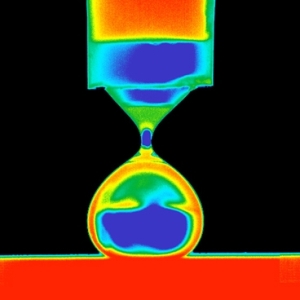People living in older buildings often hear pounding noises in their plumbing or radiator pipes — it’s a well-known effect called a water hammer, which can occur when a valve is suddenly opened or closed in a pipe carrying water or steam, causing a pressure wave to travel down the pipe with enough force that it can sometimes cause the pipes to burst.
Now, new research shows that a similar effect takes places on a tiny scale whenever a droplet of water strikes a surface.
 This color-enhanced image shows a droplet of water being deposited on a superhydrophobic surface, just before it separates from the dropper used to deposit it.
This color-enhanced image shows a droplet of water being deposited on a superhydrophobic surface, just before it separates from the dropper used to deposit it.
MIT’s Kripa Varanasi, co-author of a report on the new finding published this week in the journal Physical Review Letters, says the phenomenon could help engineers design more durable condensing surfaces, which are used in desalination plants and steam-based power plants. Other co-authors include MIT mechanical-engineering graduate students Hyuk-Min Kwon and Adam Paxson, and associate professor Neelesh Patankar of Northwestern University.
Varanasi, the d’Arbeloff Assistant Professor of Mechanical Engineering, says the effect explains why blades used in power-plant turbines tend to degrade so rapidly and need to be replaced frequently, and could lead to the design of more durable turbines. Since about half of all electricity generated in the world comes from steam turbines — whether heated by coal, nuclear fuel, natural gas or petroleum — improving their longevity and efficiency could reduce the down time and increase the overall output for these plants, and thus help curb the world emissions of greenhouse gases.
There has been widespread interest in the development of superhydrophobic (water-repelling) surfaces, Varanasi says, which in some cases mimic textured surfaces found in nature, such as lotus leaves and the skin of geckos. But most research conducted so far on how such surfaces behave have been static tests: To see the way droplets of different sizes spread out on such surfaces (called wetting) or how they bead up to form larger droplets, the typical method is to add or subtract water slowly in a stationary droplet. But this is not a realistic simulation of how droplets react on surfaces, Varanasi says.
“In any real application, things are dynamic,” he says. And Varanasi’s research shows the dynamics of moving droplets hitting a surface are quite different from droplets formed in place.
Specifically, such droplets undergo a rapid internal deceleration that produces strong pressures — a small-scale version of the water-hammer effect. It is this tiny but intense burst of pressure that accounts for the pitting and erosion found on power-plant turbine blades, he says, which limits their useful lifetime.
“This is one of the biggest unsolved problems” in power-plant design, he says. In addition to damaging the blades, the formation and growth of water droplets mixed with the flow of steam saps much of the power, accounting for up to 30 percent of the system losses in such plants. Since some steam-based power plants, such as natural-gas combined-cycle plants, can already have efficiencies of up to 85 percent in converting the fuel’s energy to electricity, if these droplet losses could be eliminated it could provide almost a 5-percent boost in power.
“This is a new finding, indeed,” says David Quéré, director of research at the laboratory of physics and mechanics of heterogeneous materials at ESPCI, Paris. He explains that “Superhydrophobic materials, on which water can glide and roll in a unique fashion, have interesting properties, provided water stays at the tops of the decorations we find on them. (I like to call that the fakir effect, since water then sits at the tops of a bed of micro-nails.)”
This research, Quéré says, explains why droplets often fail to stay on top and instead get impaled on the “nails,” and so the new findings are “interesting in the context of superhydrophobic materials, because it helps to design materials able to resist this kind of detrimental effect.”
Small-scale texturing of surfaces can prevent the droplets from wetting the surfaces of turbine blades or other devices, but the spacing and sizes of the surface patterns need to be studied dynamically, using techniques such as those developed by Varanasi and his co-authors, he says. Regularly spaced bumps or pillars on the surface can produce a water-shedding effect, but only if the size and spacing of these features is just right. This research showed that there seems to be a critical scale of texturing that is effective, while sizes either larger or smaller than that fail to produce the water-repelling effect. The analysis developed by this team should make it possible to determine the most effective sizes and shapes of patterning for producing superhydrophic surfaces on turbine blades and other devices.
The work is related to Varanasi’s research on how to prevent ice formation on airplane wings, also using nano-texturing of surfaces, but the potential applications of this latest research are much broader. In addition to power-plant turbines, this could also affect the design of condensers in desalination plants, and even the design of inkjet printers, whose operation is based on depositing droplets of ink on a surface.
This work was funded by the MIT Energy Initiative, the National Science Foundation, the Dupont-MIT Alliance, and the Initiative for Sustainability and Energy at Northwestern. MIT’s Edgerton Center also provided high-speed video equipment.
Source: http://web.mit.edu/